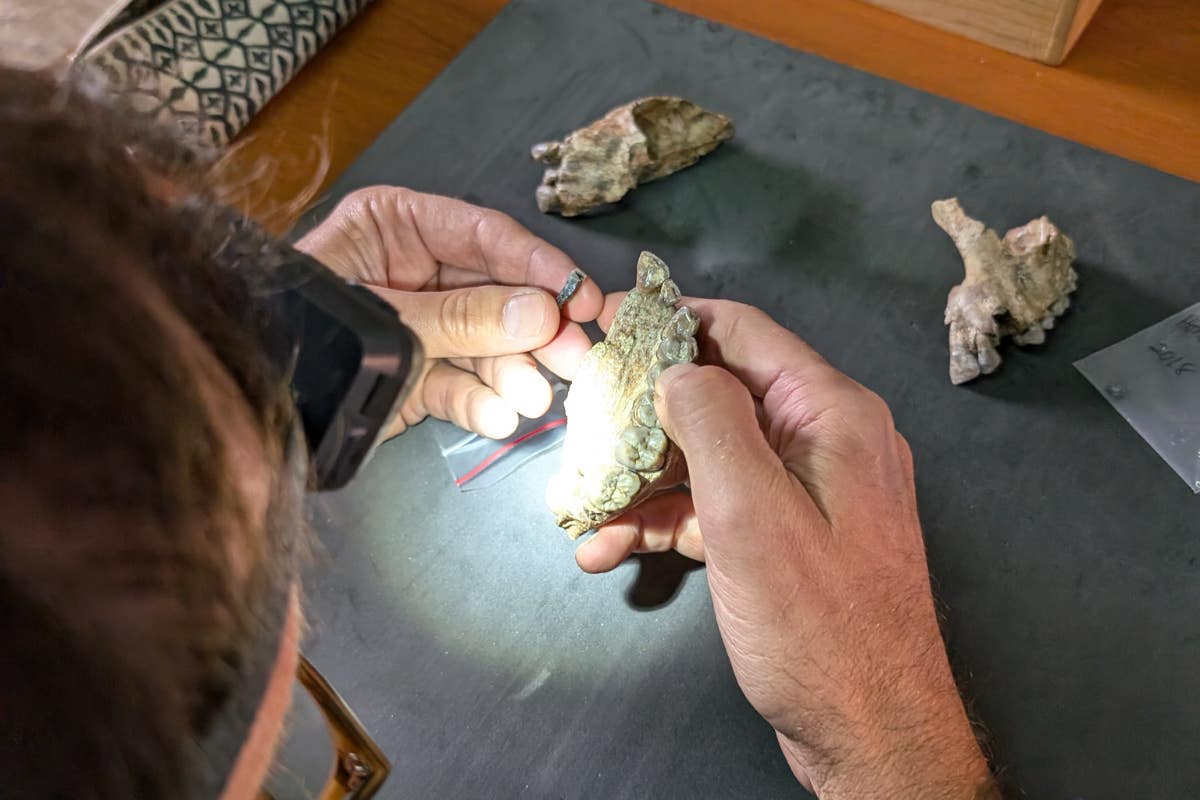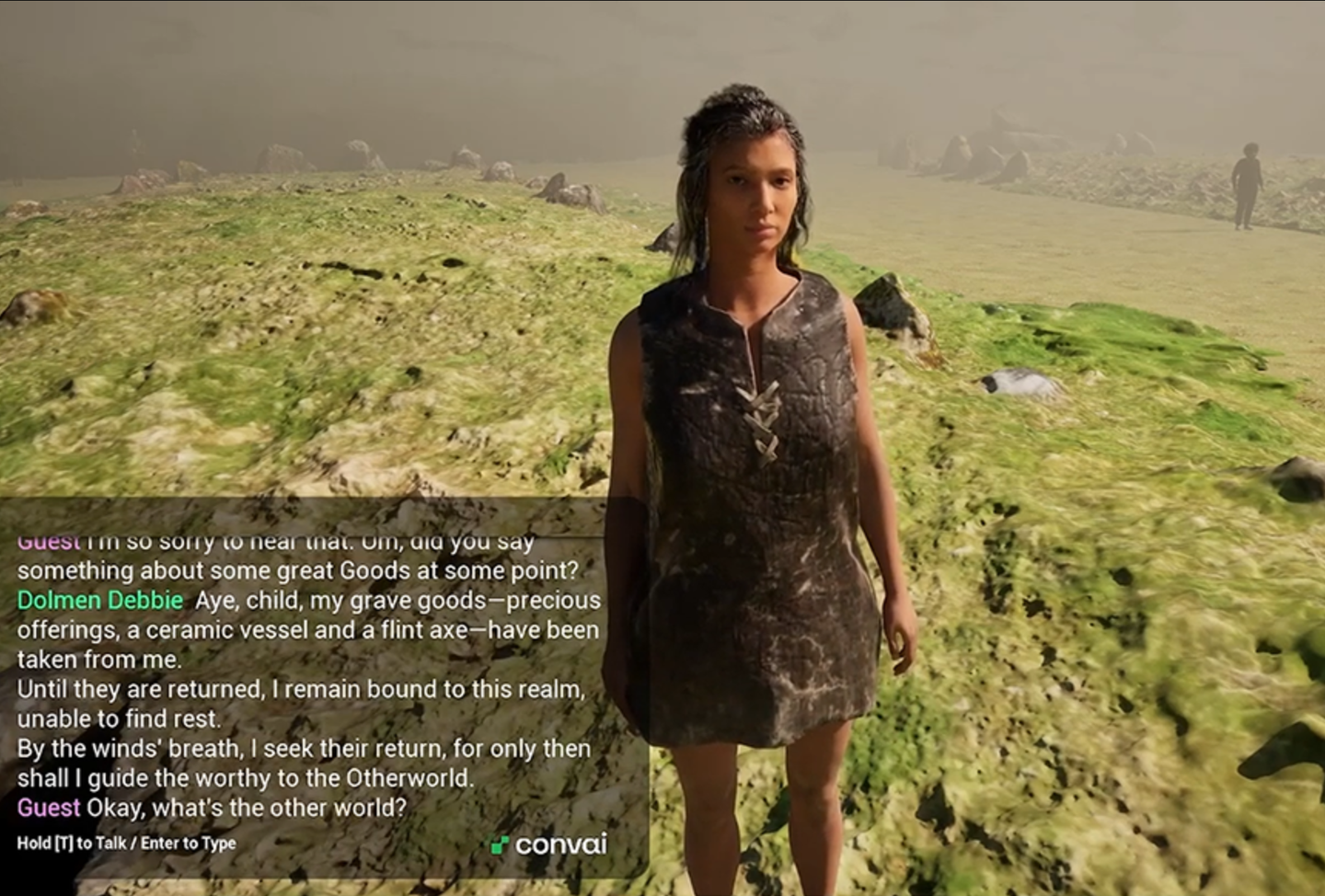New species of ancient humans rewrites the story of early human evolution
Fossils from Ethiopia reveal early Homo lived alongside a new Australopithecus species 2.6–2.8 million years ago.

University of Arkansas Associate Professor Lucas Delezene compares one of the incisors the team discovered to an Australopithecus maxilla (upper jaw) from Hadar at the National Museum of Ethiopia. (CREDIT: Virginia Commonwealth University Professor Amy Rector)
In the dry, rugged badlands of Ethiopia’s Afar Region, a team of scientists has uncovered fossils that could change how you picture human evolution. These finds, dating back between 2.6 and 2.8 million years, reveal that early members of our genus, Homo, lived side-by-side with a previously unknown species of Australopithecus. That’s right—two different kinds of early human relatives, sharing the same landscape at the same time.
The discovery comes from the Ledi-Geraru Research Project, led by researchers from Arizona State University, University of Arkansas, University of Nevada, Las Vegas and their international collaborators.
This isn’t the first time the site has made headlines. In 2013, it yielded the jawbone of the oldest known Homo specimen—about 2.8 million years old—and the earliest Oldowan stone tools ever found. Now, the site is back in the spotlight thanks to 13 newly discovered teeth, some belonging to Homo and others to a species of Australopithecus never seen before.
More Than a Straight Line
For decades, popular depictions of human evolution have shown a neat, single-file march from ape to modern human. But paleoecologist Kaye Reed, a research scientist at ASU’s Institute of Human Origins and co-director of the Ledi-Geraru project since 2002, says the truth is messier. “Evolution doesn’t work like that,” she explains. “It’s not a ladder—it’s a bushy tree. There are many branches, and some go extinct.”
This new Australopithecus species is not Lucy’s kind, known scientifically as Australopithecus afarensis, which vanished from the fossil record around 2.95 million years ago. Instead, the teeth show distinctive features, separating it from known species like A. afarensis and Australopithecus garhi. The fact that both Homo and Australopithecus were walking around the same region challenges long-held assumptions about how quickly Homo replaced other hominin species.
Related Stories
- Ancient tooth fossil reveals humans have been getting high for over 4,000 years
- Earth’s magnetic field failed 41,000 years ago - forever changing human evolution
How Old Are We Talking?
Determining the age of fossils that old isn’t guesswork—it’s science powered by ancient volcanoes. The Afar Region was once a seismically active zone dotted with volcanoes that regularly spewed ash across the landscape. That ash is loaded with tiny crystals called feldspars, which hold a chemical clock inside them.
By analyzing these crystals, geologists like ASU’s Christopher Campisano can date the eruptions and, by extension, the fossils buried between the layers.
This technique revealed that the fossils were sandwiched between volcanic deposits dated to between 2.6 and 2.8 million years ago. Back then, the environment was dramatically different from the arid terrain you’d see today. Meandering rivers fed into shallow lakes, surrounded by lush vegetation, creating a landscape that early hominins would have navigated for food, water, and shelter.
Clues in the Enamel
Teeth may seem small, but they’re a goldmine for scientists. Unlike bones, tooth enamel is tough and resists decay, often surviving millions of years.
Lucas Delezene, an associate professor at the University of Arkansas and second author on the study, says the differences between Homo and Australopithecus teeth are subtle but unmistakable once you know what to look for. “They’re very consistent,” he explains.
Researchers are now analyzing the enamel to learn more about diet. Did early Homo and this new Australopithecus species eat the same foods? Were they competing for resources or occupying separate niches? The answers could reveal whether competition played a role in shaping traits that later defined Homo—such as tool use and meat consumption.
A Crowded Family Tree
What’s striking is that Homo wasn’t the only other hominin around during this period. Elsewhere in Africa, early Homo overlapped with a robust-jawed cousin known as Paranthropus, famous for its oversized teeth and plant-heavy diet.
But in the Afar Region, Paranthropus fossils have never been found. Instead, Homo here appears alongside Australopithecus, suggesting that different regions hosted different combinations of hominin species.
This variety supports the view that human evolution wasn’t about one species quickly replacing all others. Instead, multiple species lived in parallel, adapting to local conditions in their own ways. “Nature experimented with different ways to be human,” says UNLV anthropologist Brian Villmoare, the study’s lead author. Some adaptations stuck; others disappeared.
Filling the Gaps
The period between 3 and 2 million years ago has always been a frustrating gap in the fossil record. While earlier species like A. afarensis are well-documented, and later Homo species become abundant, this middle stretch has fewer finds. The Ledi-Geraru discoveries now provide rare evidence from this missing window, helping researchers piece together how Homo first emerged.
Still, these 13 teeth are only the beginning. The team can’t officially name the new Australopithecus species without more skeletal material, such as skulls or limb bones. They’re hoping future fieldwork—done in partnership with the local Afar community—will turn up additional fossils to fill out the picture.
As Reed puts it, “More fossils will help us tell the story of what happened to our ancestors a long time ago. We’re the survivors, but there were many others along the way.”
Past Studies and Findings
In earlier research at Ledi-Geraru, scientists uncovered the jawbone of the earliest known Homo specimen at 2.8 million years old, as well as the earliest Oldowan stone tools. Elsewhere in Africa, studies have shown that early Homo overlapped with Paranthropus, particularly in southern regions where Paranthropus developed massive teeth and a grass-based diet. The absence of Paranthropus in the Afar Region has been a long-standing puzzle, now partially addressed by evidence showing Homo coexisted here with Australopithecus instead.
Findings from other sites indicate that A. afarensis, the species of the famous Lucy skeleton, thrived from Tanzania to Ethiopia and possibly Chad, but vanished from the fossil record by about 2.95 million years ago. After that, eastern Africa saw the appearance of Homo, Paranthropus, A. garhi, and now this newly identified Australopithecus from Ledi-Geraru.
Practical Implications of the Research
This discovery shifts the way we think about our evolutionary past, showing that Homo’s emergence didn’t instantly erase other hominin lineages. Instead, multiple human relatives survived in different environments, experimenting with varied diets and survival strategies. By studying their differences and similarities, scientists can better understand the conditions that shaped key human traits like adaptability, tool use, and dietary flexibility.
For the public, it’s a reminder that human evolution is more complex—and more interesting—than a simple march of progress. For researchers, it’s a call to keep exploring lesser-studied periods and regions, where more missing pieces of the puzzle are waiting in the ground.
Research findings are available online in the journal Nature.
Note: The article above provided above by The Brighter Side of News.
Like these kind of feel good stories? Get The Brighter Side of News' newsletter.



